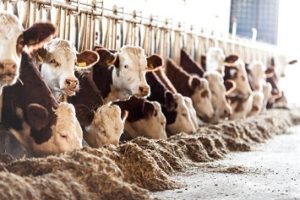EPA’s Office of Inspector General (OIG) reports that the Agency is years behind in meeting the terms of a 2005 agreement with the animal feeding operation (AFO) industry to develop methods to estimate emissions of hazardous air pollutants from AFOs.
The OIG has made several recommendations on how the Agency can proceed in developing the emission estimating methodologies (EEMs). However, if the EPA decides it cannot develop the EEMs, the OIG also recommends that the Agency drop the enforcement protections to which AFOs are entitled under the agreement. The EPA agreed with all OIG’s recommendations.
No CAA Regulations
About 18,000 large AFOs nationwide emit hazardous substances into the atmosphere, mainly ammonia and hydrogen sulfide. Environmental and human health advocacy groups have stated that these emissions adversely affect the health of people living near the facilities, who are disproportionately low-income people of color.
AFOs are currently subject to Clean Water Act permitting. However, there is no regulation of AFO air emissions mainly because the EPA has no method to estimate the mass air emissions of AFOs. Lacking reliable estimating methods, the EPA has insufficient data to determine if large AFOs should be permitted under the Clean Air Act and if emissions releases that reach certain thresholds should be reported as required under the Comprehensive Environmental Response, Compensation, and Liability Act (CERCLA) and the Emergency Planning and Community Right-to-Know Act (EPCRA).
Industry Data Collection
In the 2005 agreement, the AFO industry committed to conducting a study—called the National Air Emissions Monitoring Study (NAEMS)—in which it would collect data on emissions and provide them to the Agency. The agreement includes a provision whereby the Agency agreed not to sue any AFO for alleged air emissions violations until the EEMs are complete.
The industry data-collection effort was completed in 2007 at a cost of $15 million. The data were provided to the EPA, which said the EEMs would be ready for use by 2009. But, in its report, the OIG found that the Agency has not developed the EEMs and has no systematic plan or quality objectives for the EEMs.
In a podcast the OIG released with the report, Rich Jones, a program analyst with OIG’s Office of Program Evaluation, explained why the EPA has not delivered the EEMs.
“It’s a few things—limitations with the NAEMS data, uncertainty about how to address significant feedback from the EPA’s Science Advisory Board [SAB], and a lack of EPA agricultural air expertise and committed resources,” said Jones. “The EPA recently hired new staff to work on emissions-estimating methodologies development, but hasn’t yet finalized its work plan or established timeframes to finish the methodologies. Until the Agency develops sound methods to estimate emissions, it cannot reliably determine whether animal feeding operations comply with applicable Clean Air Act requirements.”
NAEMS Data Limitations
The EPA appears to have had particular difficulty resolving issues raised by the SAB. For example, the SAB found that the number of sites monitored in the NAEMS was too small relative to the size of the industry; the models were based on variables that did not accurately predict emissions; the EPA should not have combined swine and dairy lagoon/basin data; and there were significant limitations with the data on volatile organic compounds for broiler houses.
Recommendations
The OIG recommended that the EPA conduct systematic planning for future development of EEMs.
“Based on the results of this planning, the EPA should determine whether it can develop EEMs of appropriate quality for each of the emission source and pollutant combinations studied,” said the OIG. “If the EPA determines that it cannot develop certain emission estimating methodologies, it should notify agreement participants and end civil enforcement protections. For the emission estimating methodologies that can be developed, the EPA should establish public milestones for issuing the draft methodologies.”
As noted, the Agency agreed with all OIG’s recommendations.
OIG’s report is here.

